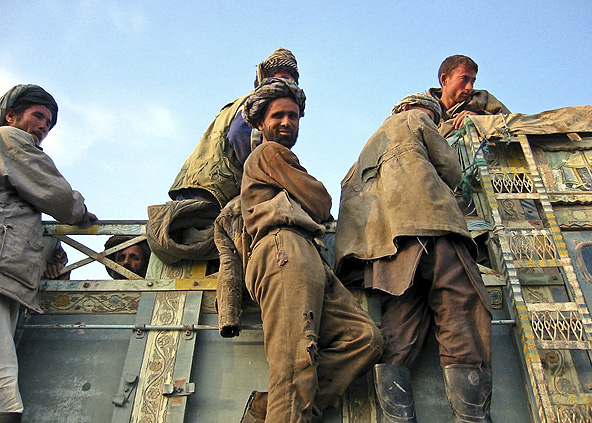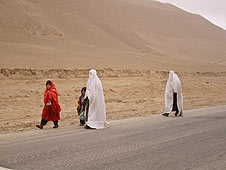
4 November, 2001. Afghan men riding on a truck as it is being ferried across the Amu Darya river from Tajikistan. This border crossing was one of the few routes into Afghanistan that were open to foreigners.
Photo: Phillip Robertson
I write down their names and ages and they keep me from getting killed.
Everyone was in a great mood. The war was coming to an end. The mujahedin were going to win.
I rode with them for a few miles, thanked them and jumped back on to the road where I soon caught sight of Amin. Sion was back in the jeep with Nazar, and when we passed Nachtwey, we slowed down to give him a lift into town.
On the outskirts of Kunduz, there were crowds of onlookers who had come out to see the mujahedin take the town, but unlike in Taloqan, they were not cheering. Older men, many of them Pashtuns, stood at the side of the road and stared at us. No jubilant shouting, no thrown coins, not even a raised hand in acknowledgement. This was the first sign that the fall of Kunduz wouldn't be like the fall of Taloqan to the east.
The column kept moving to the center of the city, where we saw hundreds more silent onlookers, some of them children. We had just crossed main bazaar when Amin told Nazar to tell me something. "Phillip, these are Kandahari people."
The men on the street were Taliban. I had just enough time to see a fighter 10 feet away in a black turban whirl around the corner of a building like a ballet dancer. Then the shooting started. It was a carefully planned ambush. The shooting started at 8 sharp. Rockets flew down the street in our direction, bright red explosive embers. The mujahedin turned their trucks around and returned fire. Rocket-propelled grenades flew over Amin's cherished jeep in both directions, knocking walls out of the buildings on the other side of the street, while fighters opened up with Kalashnikovs and machine guns. In the middle of it all, James and Sion hopped out into the street, and started snapping pictures.
Amin was terrified. He threw the wheel over and gunned it, driving back down the street and out of town, but he was stopped by the rest of the Khan's fighters who had formed a defensive perimeter at the end of the market. Amin pulled over and as soon as he had a clear shot at the road, he started driving out of town. I told Nazar to explain to Amin that the shooting was confined to the market and not to panic. "Tell him Nazar. Tell Amin to stop right here." Nazar said nothing. He was white with fear. "Tell him to stop!" Nazar wouldn't translate the command so I punched him until he said it in Dari. Amin pulled over. I got out, asked Nazar to come with me and he flatly refused. We had driven halfway out of town. As I was trying to figure out how to get up to the market to see what was going on without being killed, Amin and Nazar promptly drove off. I walked up the street listening to sniper bullets, which sound like summer bugs and make a low pitched whirr as they go past.
Every so often I'd duck into a doorway. When I stepped out into the street, more whirring. I was close to the site of the original shooting when the fighting stopped and the Kunduz residents came out to surround the dead and dying. At one place in the street, where Nazar mysteriously reappeared, there was a crowd of onlookers poking at a figure on the ground.
Nazar said, "This man says he wants to kill the injured Talib," pointing at an angry man. The crowd surged around the wounded fighter every time he moved. Some men dragged the fighter to the sidewalk, where he was instantly again surrounded by gawkers. An old man got up on a set of stairs, and begged for the life of the wounded man, which seemed to calm everyone down. I saw at least five dead Taliban scattered around the market. All of them had been shot and they were lying in large pools of blood. In the street, mujahedin were rounding up prisoners and vehicles, driving them out of town at amazing speeds. Khan's people wouldn't even take the time to hotwire a Taliban truck because they were afraid it would mean they would lose it to a rival commander. A fleet of pickups and jeeps left the city, towed by mujahedin at really respectable speeds, causing the crowds to scatter.
At 8:45 Sion found us after being pinned down by grenade fire in the street. Amin reappeared with the jeep and we decided to drive to the airport where there had been numerous reports of planes evacuating Pakistani commanders the previous evening. Near the traffic circle that marked the center of town, Amin told me point blank that he wanted $1,000 to drive us to the airport. "Forget it. You can't raise the rates just because we are in a bad situation," I said. When our driver heard that, he just turned off the car.. We didn't have time to work it out, because the Northern Alliance commanders started shooting at each other, in yet another exchange of rockets which flew over the car. I ducked and lay across the seat, and Amin ended his strike and got us back to the traffic circle but then drove off and left us for the second time.
More chaos and running. At the traffic circle, right after commander Mullah Taj Mohammed made a ridiculous speech to some recent captives, there was more shooting and several thousand panicked Kunduz residents ran down the market street like it was the end of the world. I asked a fighter what was going on and he said, "It's happy. Happy!" He tried to explain that there weren't any Taliban left and that the explosions were just jubilation, a very earnest attempt at a face-saving lie.
Soon, regular army troops came in and prevented me from going back to the traffic circle, the scene of so much internecine Northern Alliance conflict. I had witnessed several very heated arguments between truckloads of mujahedin and I had by that time seen enough to understand what was going on. Explosions around the city were probably the result similar conflicts, not just the final shootouts with the Taliban. They wanted the trucks.
 LEAD IMAGE: 20 November, 2001. Refugees on the road before the fall of Kunduz to the Northern Alliance.
LEAD IMAGE: 20 November, 2001. Refugees on the road before the fall of Kunduz to the Northern Alliance.Photo: Phillip Robertson
© Phillip Robertson, 2009-2014.
